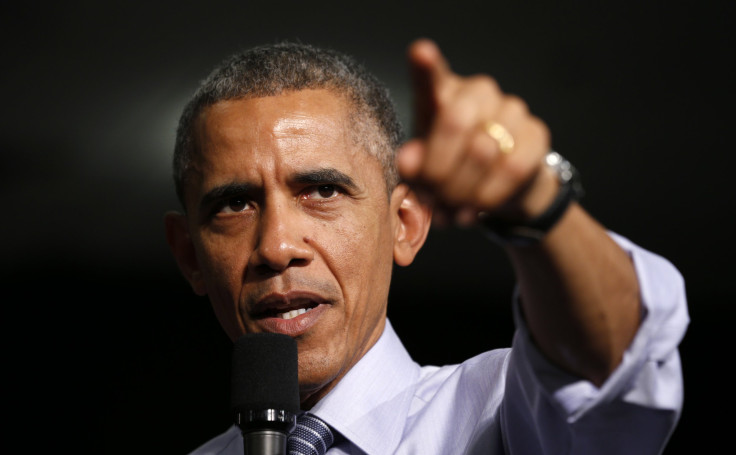Obama's Request For Authorization To Use Military Force Explained With A Legal Expert

As Congress gets ready to debate President Barack Obama’s request for renewed powers to fight terrorists including the Islamic State group, or ISIS, lawmakers from both parties already have expressed reservations about the new Authorization for Use of Military Force, saying it is not definite enough and leaves many unanswered questions.
We go over some of the key points in the draft text of the AUMF, as received by Congress on Wednesday, with Charles Stimson, an attorney who was deputy assistant secretary of defense for detainee affairs and now heads the national security law program at the conservative-leaning Heritage Foundation, a Washington-based think tank.
Use Of Ground Troops
The greatest concern expressed by lawmakers is that a new authorization to use force would end up embroiling the U.S. in a prolonged ground war, as happened in Afghanistan after a similar AUMF in 2001 giving the White House broad terrorism-fighting powers. The new draft, though, says that it "does not authorize the use of the United States Armed Forces in enduring offensive ground combat operations." Obama accompanied the draft text with a letter in which he stated there will be no offensive ground troops.
The language that has legal significance, Stimson said, is purely the text of the statute, which right now is "ambiguous."
“The term 'enduring offensive' is not defined in the operative language and there’s no precedent for it,” he said. “And I think what a lot of people are tending to overlook and not think about is the fact that because he’s keeping the 2001 AUMF and already relying on that to go after ISIS, he is not prevented from introducing ground combat troops, and in fact, there are already special forces and members of the 10th Mountain Division of the Army in Iraq.”
Congress may seek clarification on whether "ground combat operations" means small teams of special forces operators, which is more politically palatable than a large-scale operation.
Three-Year Time Line
The AUMF will expire in three years “unless reauthorized” by Congress. That represents Obama’s attempt, according to Stimson, at trying to placate Democrats worried that the conflict could turn into a protracted war. The president also could be aiming at satisfying the Republican majority in Congress, which includes hawks who don't want to appear soft on terrorism.
“He’s trying to thread the needle here by giving something to the anti-war left, by saying 'it’s not an endless war,' but he also knows that some Republican senators will not tolerate that sunset provision, so he’s left in language that gives hope that it can be extended in the future,” Stimson said.
Location Of Military Action
Missing from the current draft text is an explanation of where the "military force" being authorized will actually be employed. It’s assumed that it will primarily be in Syria and Iraq, Stimson said -- that is where the Islamic State group has created its self-styled "caliphate." But the lack of a defined location suggests that the request will be limitless in its reach, according to Stimson.
“This is consistent with what Secretary Kerry testified [about] last December when he said four things have to be in an AUMF, including no limitations of geographical location,” Stimson said. “I doubt the security forces would have gone along with this if they had put in a geographical limitation, which is why Obama has not added it."
But even a theoretically limitless reach would not be limitless in practice. If ISIS fighters were found to be operating in Europe, for example, the U.S. would work with its partners in combating that threat. "It's not like we'll see drone strikes in Glasgow or Manchester or anything like that," Stimson said.
Who Is It Aimed At?
The draft AUMF states that the military can go after “associated person or forces,” which means “individuals and organizations fighting for, on behalf of, or alongside ISIL [what the White House calls ISIS] or any closely related entity in hostilities against the United States or it coalition partners.”
This language may be meant to avoid legal issues that arose from the 2001 AUMF, which did not list specific enemy combatants, according to Stimson, but only “those nations, organizations or persons he [President George W. Bush] determined planned, authorized, committed or aided the terrorist attacks that occurred on Sept. 11, 2001.”
"No enemies were specified until years later when it was decided by U.S. courts that they were officially al Qaeda, the Afghan Taliban and associated forces," Stimson said. The U.S. courts were able to use the term “associated forces” in bringing charges against terrorists who were not clearly linked to one of the named terror groups.
“They want that language to mirror the existing language in case law, so that it doesn’t cause a ripple effect to any of the 9/11 authorities and can be used in the future to prosecute Islamic State terrorists,” Stimson said.
What Does Congress Say?
Speaker of the House John Boehner, R-Ohio, said Wednesday that while he was willing to let the legislative process take its course, he still was concerned about the lack of flexibility in the president's draft. "I'm not sure that the strategy that's been outlined will accomplish the mission the president says he wants to accomplish. And his point, the president's point is that he wants to dismantle and destroy ISIS. I haven't seen a strategy yet that I think will accomplish that," Boehner said.
Democratic Sen. Martin Heinrich of New Mexico said he also had “serious concerns” about the language surrounding ground troops, saying that “there’s a potential for abuse there that I’d very much like to see narrowed.”
© Copyright IBTimes 2024. All rights reserved.






















